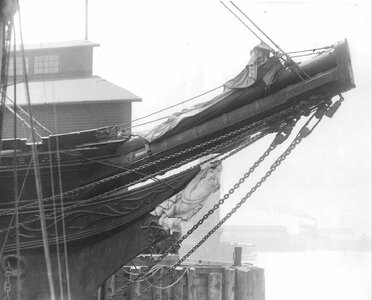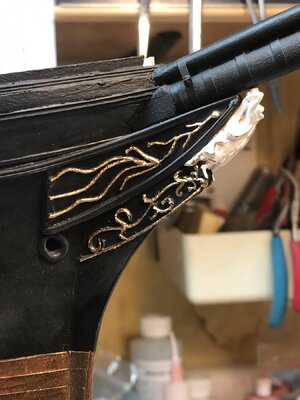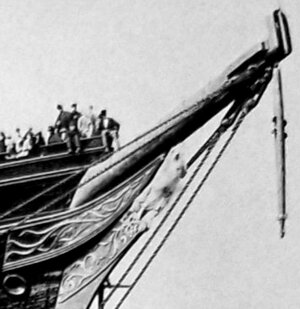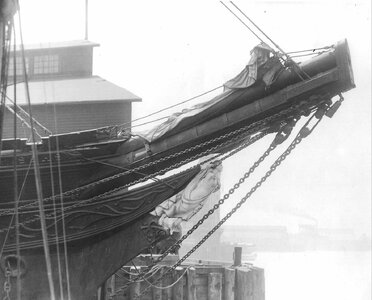- Joined
- May 21, 2023
- Messages
- 470
- Points
- 238

Bill,Hi Peter,
I was thinking of the naval hood as a purely decorative piece, but it makes sense that it would add a great deal of strength to the stem area.
Bill
I honestly believe that's where well meaning researchers like Scott Bradner and so many others have missed the mark on McKay's nautical genius. They're thinking in terms of purely decorative value, such as trail boards, etc. But by not being able to grasp the structural significance of the naval hood-cutwater combination they completely dismissed them as fanciful decorations. That's precisely what Duncan McLean said these devices were not. Look very closely at these contemporary scenes of and note how tightly the naval hoods adhere to her hull. They are decorated with carvings that originally were gilded but that's where they differ. They're really an integral component and extension of the ship's hull itself. Since they're also crossbolted to each other right through the cutwater which is sandwiched below, they make for a practically indestructible prow. All three of these structures: cutwater and both naval hoods form a far more sturdy base for the massive bowsprit-jibboom combination mounted just above. Which reminds me, both of those spars while round outside of the bow, are actually squared off just before entering the hull. Close examination of these images reveals this. Also note, the inner Jibboom gets reduced slightly in size about 6' out. courtesy PEM, Salem, MA
(1) close-up 1869 detail of Glory of the Seas on the ways, shortly before her launch. Her Naval hood is the large reverse curving arch which ends in a point above and behind the figurehead. Note how tightly these devices hug the ship's prow. There's almost no cast shadow to see underneath. Below that is the cutwater (part which is visible, in reality a larger portion is sandwiched between both naval hoods. Figurehead has her feet mounted on the cutwater scrollwork, behind her, where it is hidden, is a large iron bar that also mounts her to the naval hoods behind her. This is the unique McKay bow.
(2) 1913 Muir photo: starboard broadside Glory of the Seas prow. Intact naval hoods with all original carvings, intact cutwater missing most of her ornate acanthus leaf overlay. Highest bulwark, her splashrail is cracked. That's the total visible damage from a steam ship colliding with her.
(3) Rob Wiederrich's 1:96th scale Glory of the Seas model, in the same position. Compare and contrast this far more elegant prow to other McKay models with just a bare stem. Difference is night and day. For the record, Rob and Vladimir's models are the first known examples to finally display an accurate McKay bow.


Last edited:











